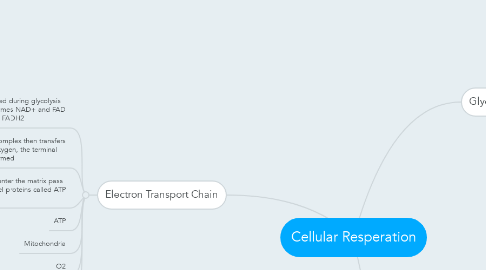Cellular Resperation
by Victoria Stutzman

1. Electron Transport Chain
1.1. FADH2: When glucose is oxidized during glycolysis and the krebs cycle, the co-enzymes NAD+ and FAD are reduced to NADH+ H+ and FADH2
1.2. Water: The cytochrome oxidase complex then transfers electrons from cytochrome c to oxygen, the terminal electron acceptor, and water is formed
1.3. ATP synthase: Protons that reenter the matrix pass through special proton channel proteins called ATP synthase
1.4. ATP
1.5. Mitochondria
1.6. O2
1.7. ADP
2. Glycolysis
2.1. Cytoplasm: Does not require oxygen
2.2. ADP: The result is a 6-carbon sugar diphosphate molecule and 2 low energy ADP
2.3. ATP: The energy released during these oxidation reactions is used to form ATP
2.4. NAD+: Each of the 3-carbon molecules is converted through a series of steps, to pyruvate
2.5. NADH: Electrons are transferred to the coenzyme NAD+ to form NADH
2.6. Pyruvate: Converted into lactic acid
2.7. Glucose: Broken down to two molecules of pyruvate
3. Krebs Cycle
3.1. Pyruvate: Glucose is broken down to pyruvate
3.2. Mitochondria: A 2-carbon fragment of pyruvate is used to form acetyl-CoA, then enters krebs cycle
3.3. NADH: During the conversion of pyruvate to acetyl-CoA, CO2 is produced to make NADH
3.4. NAD+: Hydrogen is removed and transferred to NAD+
3.5. ATP: A second oxidation and decarboxylation accurs producing ATP
3.6. FADH2: The 4-carbon molecule is further oxidized and the hydrogens that are moved are used to form FADH2
3.7. CO2: Used in many ways throughout the krebs cycle
3.8. Cytoplasm
3.9. ADP
3.10. FAD


